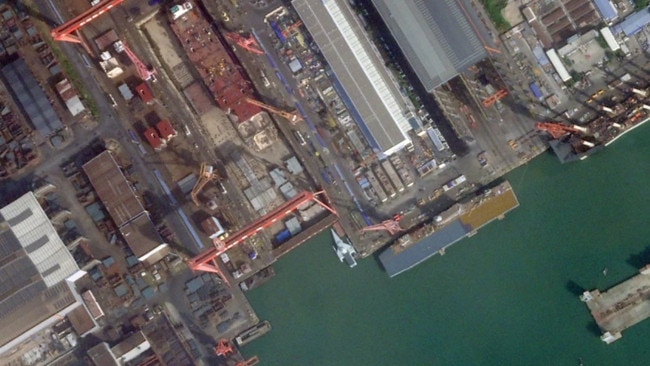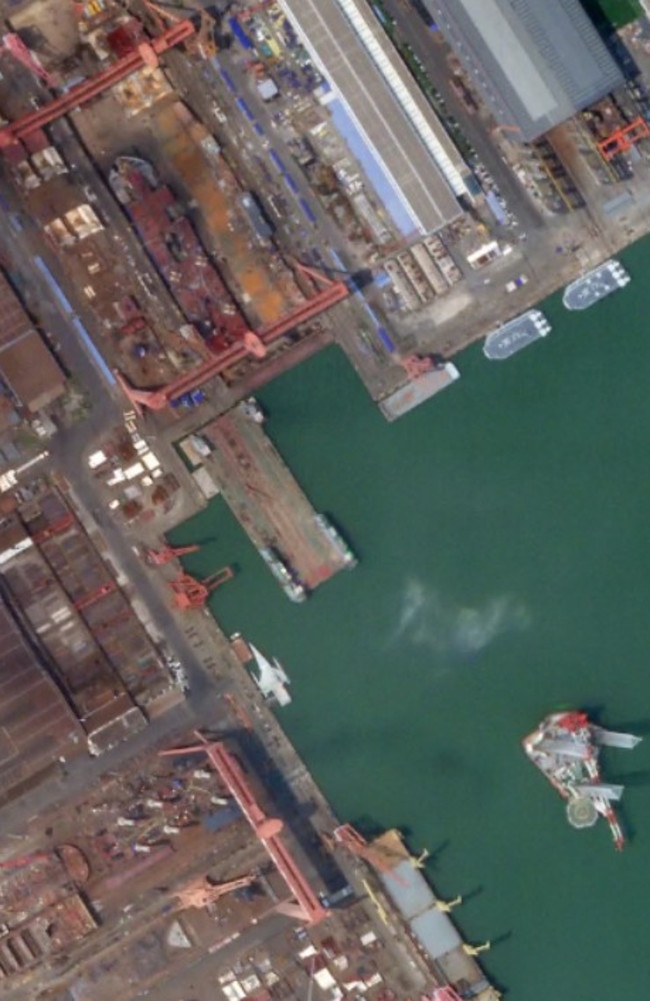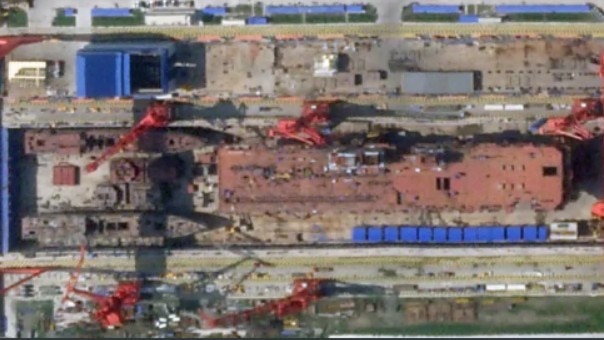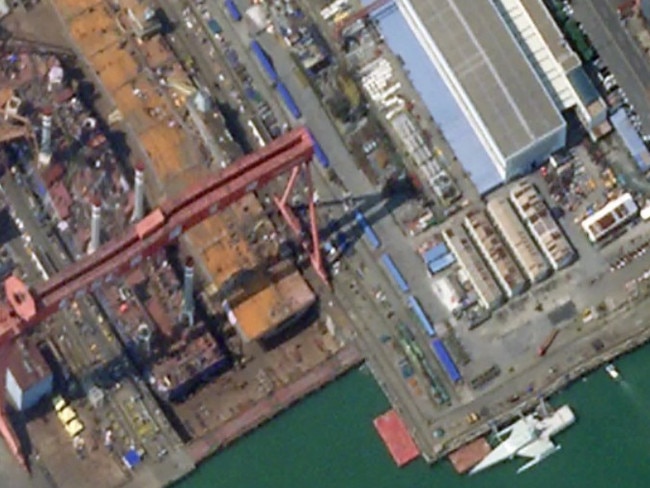Satellite photographs uncover chilling China secret
The images show an unusual ship with a new design that has been built within months, raising fears that China is now on a war footing.

Innovation
Don't miss out on the headlines from Innovation. Followed categories will be added to My News.
China has built a new aircraft carrier in less than six months, raising fears that its enormous civilian industrial might is now on a war footing.
New satellite photos show an unusual ship tied up at the civilian Guangzhou Shipyard in southern China’s Guangdong Province.
It’s a new design.
And it is clearly a ship explicitly built for high-intensity aircraft operations – whether they be large drones or crewed combat jets.

Centre for a New American Security (CNAS) analyst Tom Shugart has drawn attention to the vessel’s appearance in posts on social media.
“With the roughly 200m length and 40m beam, that would put this ship at somewhere around the size of the JSDF’s Hyuga-class DDH [helicopter carrier] (197m by 33m), and a displacement of perhaps 15-20,000 tons,” he noted.
So it just jumped out to me that next to the possible new Chinese USV is what looks like might be...possibly a new aircraft carrier or amphibious assault ship of some sort? 🤔😯
— Tom Shugart (@tshugart3) October 28, 2024
Appears to be about 200m long, with a beam of about 40m, and two islands on one side of the deck. https://t.co/XXOcQeUTIBpic.twitter.com/oHhMWYWQFZ
But satellite photos of the construction facility reveal assembly work on the ship only became evident in May.
That means it took less than six months to go from disassembled components to a watertight vessel ready to be launched.
Speculation surrounds the ship’s purpose. Is it a civilian research vessel? Or a new class of rapid-construction drone warfare ship? Or both?

Civilian cargo ships were rapidly adapted as “Woolworth’s carriers” in World War II – small ships capable of carrying a handful of aircraft. But such “baby carriers” won the Battle of the Atlantic against German submarines and contributed to frontline strikes in the Mediterranean and Pacific Oceans.
“Assessments fail to recognise how much China’s defence industrial base is growing,” warns CSIS senior analyst Seth Jones.
“Despite the country’s current economic challenges, its defence spending is soaring, and its defence industry is on a wartime footing.
“Indeed, China is rapidly developing and producing weapons systems designed to deter the United States and, if deterrence fails, to emerge victorious in a great-power war.”

Closing the ‘carrier gap’
Beijing’s enormous naval expansion has lifted a previously insignificant force to a serious challenger to the title of the world’s greatest navy in just 20 years.
While it now has more warships in total than the United States, it has only three relatively small aircraft carriers and six nuclear-powered attack submarines. The United States Navy has 11 large nuclear-powered aircraft carriers and 66 nuclear-powered attack submarines.
But the US is severely limited in its ability to build more.
“China now leads: it has become the world’s largest shipbuilder by far, with a capacity roughly 230 times as large as that of the United States,” Jones said.
And Chairman Xi Jinping’s long-term policy of integrating the civilian and military manufacturing base appears to be ramping up further.
Analysts have been aware that its civilian car-carrying ferries are being built to military specifications for years.
China's New Toy--Scientific Research Aircraft Carrier 😎 pic.twitter.com/wetiUq8VMS
— 彩云香江 (@louischeung_hk) September 14, 2022
That means their cargo decks are strong enough to hold tanks and roll-on roll-off ramps can connect with specialist landing craft to carry vehicles to a beach.
If it is a civilian research vessel, the new aircraft operating ship at Guangzhou Shipyard may likewise be dual-purpose by design.
Its appearance certainly suggests so.

The presence of two command-and-control “islands” on its deck indicates an intention for high-intensity flight operations. It’s a feature first seen in the Queen Elizabeth class aircraft carriers currently operated by the United Kingdom.
Keeping ship and air command functions separate allows each set of crew to focus solely on the task at hand. And analysts note the new ship’s size would be well suited to operating China’s new class of autonomous GJ-11 “Sharp Sword” stealth combat drones.
Military-civilian ‘fusion’
Chairman Xi Jinping has repeatedly asserted his desire to initiate a “great rejuvenation of the Chinese nation on all fronts”.
His country is now a world economic superpower.
And its forces have been testing defences along its borders with India, South Korea, Japan, Taiwan, the Philippines, Vietnam, Malaysia and Indonesia.
Now, a new report from the Jamestown Foundation think-tank in Washington DC has highlighted the growing political influence of Chairman Xi’s military-industrial complex in Beijing’s halls of power.

“Supreme leader Xi Jinping has provided consistent support to the defence industry in recent years and has increased his reliance on officials from defence industry backgrounds,” the report by analysts Arthur Ding and Tristan Tank states.
A few months ago, Mike Dahm of @MitchellStudies found a new dedicated drone carrier at another shipyard, but that was much smaller at about 80m length. https://t.co/tnzPLq6nCT
— Tom Shugart (@tshugart3) October 28, 2024
They identify officials in key political resource allocation, policy planning, co-ordination and propaganda roles.
“This strengthens the military-industrial sector’s advantage in the overall allocation of resources and policy focus and suggests that the country’s military technology and equipment production capabilities may be further enhanced than ever before,” they state.
The outcome of this apparent understanding that “logistics win wars, tactics win battles” approach is already apparent in China’s military build-up, said CSIS’s Jones.
“China is now a military heavyweight, and the US defence industrial base is failing to keep up,” he stated.
“US defence production has atrophied, and the system lacks the capacity and flexibility that would allow the US military to deter China and, if a conflict does break out, to fight and win a protracted war in the Indo-Pacific region or a two-front war in Asia and Europe.”
Jamie Seidel is a freelance writer | @JamieSeidel
Originally published as Satellite photographs uncover chilling China secret





